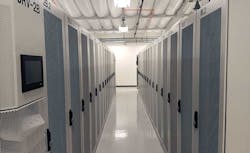In a sign of strengthening demand for water-cooled racks, high-density hosting specialist Colovore has fully pre-leased a 2 megawatt expansion phase of its data center in Santa Clara, Calif., the company announced this week. Colovore will deliver the new data hall in the fourth quarter of this year, and is now starting work on Phase 3, which will provide another 2 megawatts of IT capacity.
The strong leasing at Colovore is the latest sign that new technologies are driving higher rack power densities in the data center. Both the second and third phases of Colovore’s facility will support 35kW of critical load per cabinet.
“We are clearly seeing increasing rollout of power-hungry, dense server platforms supporting a number of fast-growing applications,” stated Sean Holzknecht, President and Co-Founder of Colovore. “Artificial intelligence, Big Data, self-driving cars, and the Internet of Things are exploding, and data centers need different engineering standards and capabilities to support the powerful underlying IT infrastructure. That is our specialty at Colovore.”
Cooling Doors Gain Traction
Colovore’s Santa Clara data center uses racks equipped with water-chilled rear-door cooling units from Vertiv (previously Emerson Network Power). It’s among a number of data center operators that are turning to cooling doors to brinf water to the rack to handle higher densities. LinkedIn is using rear-door cooling units from Motivair for its new facility near Portland, while newcomer Nautilus Data Technologies is planning to offer racks with rear-door heat exchangers from ColdLogik.
Over the past decade, there have been numerous predictions of the imminent arrival of higher rack power densities. Yet extreme densities have remained limited, primarily seen in HPC. The consensus view is that most data centers average 3kW to 6kW a rack, with hyperscale facilities running at about 10kW per rack.
But that appears to be changing. Colovore launched in 2014 seeking to offer high-density hosting as a differentiator in a crowded Santa Clara market. The company’s data center on Space Park Drive is nearly surrounded by facilities operated by Digital Realty, the industry’s largest player. Most of Colovore’s early customers weren’t pushing its infrastructure to its limits. Rack densities averaged 11 kW at first, with some clients hitting 18 kW. Later customers in the first phase started pushing higher densities, prompting Colovore to design Phase 2 for higher densities of 35 kW a rack.
AI Boosts Power Densities
The Colovore team says the growth of cloud computing and artificial intelligence (AI) is bringing more high-density workloads into data centers, and customers are more willing to put more equipment into their cabinets and seek out facilities that can cool them.
The rise of artificial intelligence, and the GPU computing hardware that often supports it, is reshaping the data center industry’s relationship with power density. New hardware for AI workloads is packing more computing power into each piece of equipment, boosting the power density – the amount of electricity used by servers and storage in a rack or cabinet – and the accompanying heat. The trend is challenging traditional practices in data center cooling, and prompting data center operators to adapt new strategies and designs.
All signs suggest that we are in the early phase of the adoption of AI hardware by data center users. For the moment, the trend is focused on hyperscale players, who are pursuing AI and machine learning at Internet scale. There are also high-density users emerging from genomics research, including a cluster of customers at the ScaleMatrix in San Diego, which uses a custom cabinet to house extreme workloads.
But soon there will be a larger group of companies and industries hoping to integrate AI into their products, and in many cases, their data centers.
Colovore will keep building for those higher densities, and they won’t be alone.
About the Author


